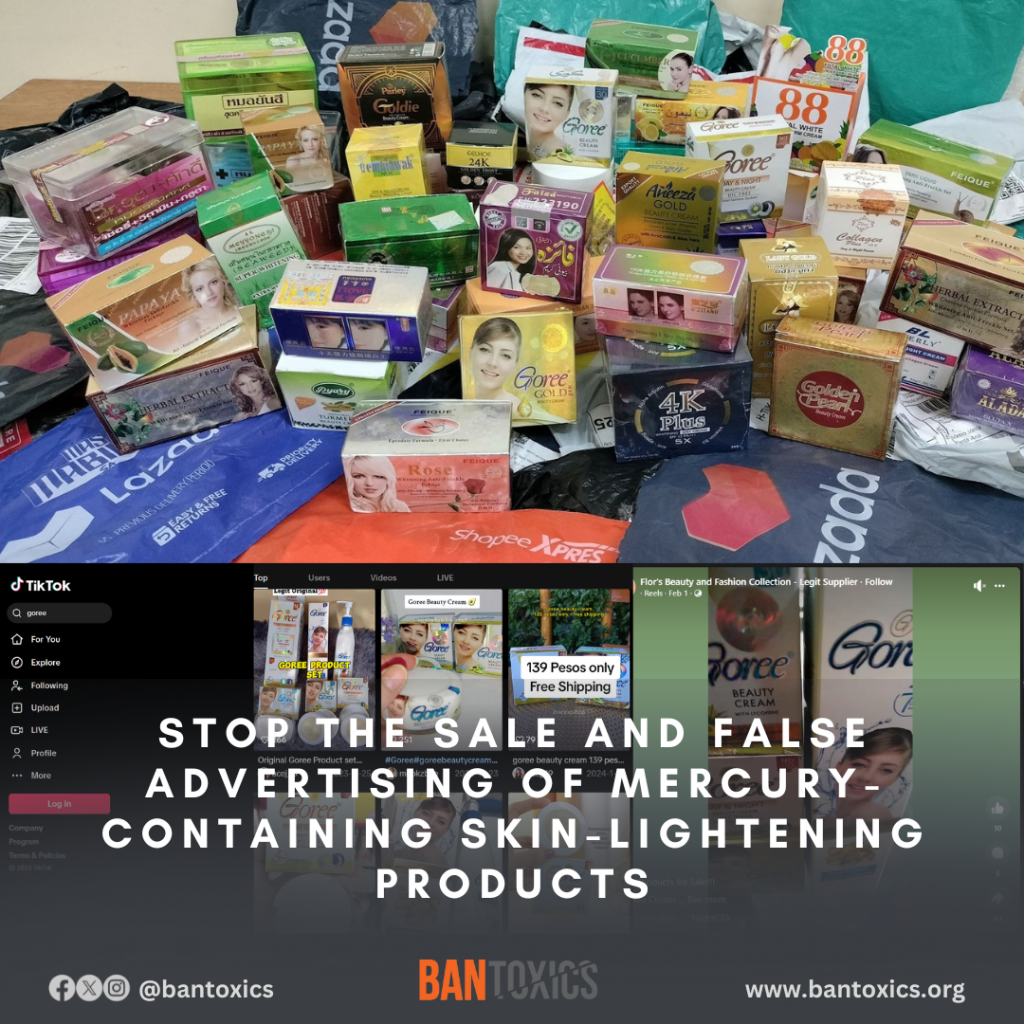Toxic Beauty: Online Platforms Fuel the Spread of Dangerous Mercury-Laden Skin Lightening Products
The digital age has revolutionized the way we access information and purchase products. However, this convenience comes at a cost, as online platforms have become breeding grounds for the proliferation of dangerous and illegal products. A recent investigation by the toxic watchdog group, BAN Toxics, has revealed a disturbing trend: the continued and widespread availability of skin-lightening products containing hazardous levels of mercury, openly advertised and sold across popular social media sites and e-commerce platforms. This alarming discovery underscores the urgent need for stricter regulations, increased platform accountability, and greater public awareness about the dangers lurking behind these deceptively marketed products.
BAN Toxics, in its latest social media monitoring efforts, uncovered a bustling online marketplace for these banned cosmetics, primarily on platforms like TikTok, Facebook Reels, Lazada, and Shopee. These products, often marketed with promises of fairer skin and a flawless complexion, conceal a sinister secret: dangerous levels of mercury, a potent neurotoxin. The group’s findings highlight not just the availability of these products, but the sophisticated marketing strategies employed by sellers, often leveraging the influence of content creators to reach a wider audience and normalize the use of these hazardous cosmetics. This exposes a vast and vulnerable consumer base to serious health risks, often unknowingly.
The extent of the problem is truly staggering. Last year, BAN Toxics purchased 50 different skin-whitening products from various online retailers and subjected them to rigorous testing using a Vanta C Series XRF Handheld Chemical Analyzer. The results painted a grim picture: a shocking 44 out of the 50 products tested positive for mercury, with levels ranging from 7 parts per million (ppm) to an astounding 67,400 ppm. To put this into perspective, the ASEAN Cosmetics Directive sets the permissible limit for mercury in cosmetic products at a mere 1 ppm. Furthermore, 33 of the mercury-laden products had already been flagged by the Food and Drug Administration (FDA) in public health advisories issued between 2013 and 2024, demonstrating the ongoing struggle to effectively curb the sale of these dangerous products.
The health implications of mercury exposure are severe and far-reaching. The World Health Organization (WHO) classifies mercury as one of the top ten chemicals of major public health concern. Even small amounts of mercury absorbed through the skin can accumulate in the body, causing a range of debilitating health problems. Exposure is particularly dangerous for pregnant women and young children, as mercury can interfere with fetal development and cause neurological damage in early childhood. The toxin also poses serious risks to the nervous, digestive, and immune systems, as well as the lungs, kidneys, skin, and eyes. The continued availability of these products online represents a significant public health crisis, demanding immediate and decisive action.
Thony Dizon, Advocacy and Campaign Officer of BAN Toxics, expressed deep concern over the persistent presence of these illegal products online, stating, "We are dismayed that some content creators and online sellers continue to use social media platforms to advertise and sell prohibited beauty products despite existing chemical regulations in the country. The sale and promotion of mercury-laden beauty products must stop.” This sentiment highlights the crucial role that social media platforms and e-commerce sites play in either exacerbating or mitigating this problem. Their current lack of effective monitoring and enforcement allows unscrupulous sellers to exploit the reach and influence of these platforms, putting countless consumers at risk.
The issue is further complicated by the rampant misinformation surrounding these products. Despite being illegal due to their high mercury content, these products are often marketed with misleading claims, touting their effectiveness and safety, further endangering unsuspecting consumers. The recent decision by Meta to remove fact-checking labels from Facebook and Instagram adds another layer of complexity, creating an environment where misinformation can proliferate unchecked. This lack of accountability and oversight allows misleading marketing tactics to thrive at the expense of public health. BAN Toxics emphasizes the urgent need for stronger enforcement mechanisms and greater accountability from social media platforms to combat the spread of misinformation and protect consumers from these harmful products.
The Call to Action: A Multi-Pronged Approach to Protecting Consumers
BAN Toxics’ investigation serves as a stark reminder of the dangers lurking in the unregulated corners of the online marketplace. The group urgently calls upon social media platforms, online sellers, and content creators to prioritize consumer safety and cease the promotion and sale of these hazardous products. This requires a proactive approach, including stricter content moderation policies, robust monitoring systems, and the swift removal of any content promoting or selling these illegal cosmetics. Content creators, who wield significant influence over their followers, bear a particular responsibility to ensure they are not inadvertently promoting harmful products.
Beyond individual responsibility, regulatory agencies must step up their enforcement efforts. BAN Toxics urges the Food and Drug Administration (FDA) and the Department of Trade and Industry (DTI) to launch thorough investigations into online platforms and marketplaces that facilitate the sale of these banned products. Decisive action is needed, including imposing penalties on platforms that fail to comply with existing health and safety regulations and e-commerce laws. Stronger collaboration between government agencies and online platforms is crucial to effectively combat this pervasive problem.
Furthermore, public awareness campaigns are essential to educate consumers about the dangers of mercury-laden skin-lightening products. These campaigns should highlight the health risks associated with mercury exposure and provide consumers with the tools to identify and avoid these products. Clear and accessible information, disseminated through various channels, including social media, traditional media, and community outreach programs, is vital to empowering consumers to make informed decisions about their health and safety.
The fight against the proliferation of dangerous cosmetics online requires a multi-pronged approach involving platform accountability, regulatory action, and public awareness. Only through concerted efforts can we effectively protect consumers from the harmful effects of these deceptively marketed products and ensure that the digital marketplace prioritizes public health and safety. The time for action is now.


